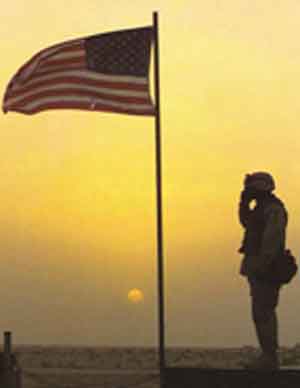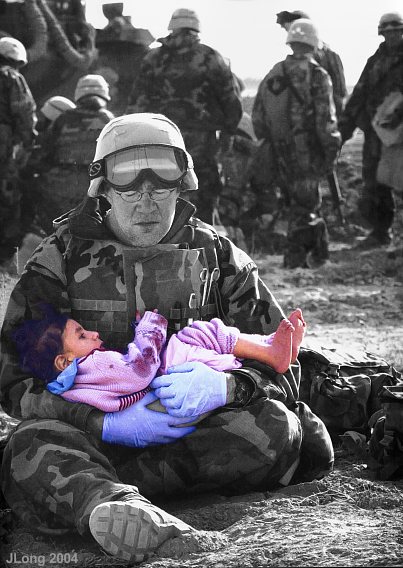
By John Wheeler
cy*********@sl*****.com
John Wheeler, USMA 66, served in Vietnam 1969-70 and in four tours in the Pentagon for four Presidents. He prepared the first Joint Munitions Effectiveness tables for nuclear and biological weapons which undergirded National Security Decision Memorandum 35 to forego US use of Biological weapons. He served as Special Assistant to the 21st Secretary of the Air Force Michael Wynne, with work focused on Cyber Warfighting and Precision Strike. He chaired the Vietnam Veterans Memorial Fund, which built the Vietnam Wall in DC, and was first Chairman and CEO of Mothers Against Drunk Driving. He is Chairman of the new American Warfighters Fund, a charity which addresses key unmet needs of America’s active duty personnel, veterans and their families.
 “The airstrike restriction increases the vulnerability of the warfighters
“The airstrike restriction increases the vulnerability of the warfighters
and therefore may enhance the rate of US KIA and WIA in Afghanistan.”
Photo Credit: http://5west.files.wordpress.com
New COIN Vs Old COIN: Reducing Collateral Damage AND Allied losses
COIN (COunter INsurgency) is the order of the day in Afghanistan. COIN provides a set of techniques appropriate to operations in close proximity to civilian populations when combating insurgents. Unfortunately, an older interpretation of COIN prior to the air-ground revolution is being applied strategically in Afghanistan. With the fielding of systems which allow for 360 degree situational awareness, Rover, and time tested (over the last decade) air-ground communications and release systems, the ground combatant commander now has actually tools for survival and effectiveness unknown in previous wars.
As we remember the Fallen on Memorial Day, we should be concerned lest adopting older COIN rules, where the ground troops are in equivalence with the insurgents, add needless US and allied casualties. With the tool sets which have evolved over the past decade, we should pursue greater air-ground integration in support of COIN, not pursue a ground operation per se.
The current interpretation of US defense counterinsurgency means organizing US defense heavily around support of “boots on the ground” in Vietnam-like war. It is a slow-paced mode of operations, personnel-intensive, expensive in personnel costs, and centered on nation building. The aim is to address mortal threats such as terrorist fission detonations in American cities by “winning hearts and minds.”
It features a return to the “fair fight” battles of the XXth century, with two sides slugging it out with high casualties. The mantra since 2006 has been that focus on anything other than the older interpretation of counterinsurgency is “Next-War-Itis” and has confused providing new integrative air-ground assets, such as F-35, with being functional equivalents to UAVs or to adding legacy aircraft buys.
In contrast, effective XXIst century operations focus on new tools, such as fifth generation aircraft and power projection assets such as the Osprey, or weapons ensuring a reduction of collateral damage and civilian casualties, such as the STB I Block 9. One wants to re-load to shape the “Unfair Fight,” with full and combined leveraging of American and allied technology and innovation:
- strategic and tactical cyber warfighting
- fifth generation (and sixth in view)
- speedy acquisition of the tankers, key to a global reach
- cyberlinks for “Reachback,” in which only minimum numbers of expensive personnel are in layers of overseas headquarters
- hyper-precise non-nuclear strike
- modern tankers replacing 50-year old—literally duct-taped—aircraft to renew the American “Air Bridge” across the world.
US Airstrike protects US and allied troops, and it finds, deters and kills enemy combatants. The Restriction on Airstrike notionally cuts back US Airstrike in order to reduce civilian casualties. General Stanley McChrystal ordered the restriction in June 2009, because he believes the level of innocent civilian casualties caused by some airstrikes to be a significant factor in causing disaffection toward the US by non-combatant Afghan citizens.
What General McChrystal has done is move in the direction of an “Army Can Go It All Alone” posture. It reverts to the XXth century Army position of the “Fair Fight”, where fairly evenly matched opponents ground forces slug it out with heavy WIA (Wounded In Action) and KIA (Killed In Action).
It equates COIN with such an approach; in reality, XXIst COIN is empowered by new tools and techniques of “360 spherical situational awareness” and air-ground integration. The USMC has pioneered these methods; now the US Army and Air Force working together can resonate with such an approach appropriate to their own integrative operations.
It is crucial not to pursue an interpretation of COIN that is XXth century in character, reminiscent of Dien Bien Phu in 1954. In the XXIst century, all that changed, and the combined US forces achieved Total Battlespace Dominance, reducing ground casualties and friendly fire incidents greatly; it also intimidates the foe from massing and from moving by day; instead, they must hide in caves and move in tiny groups at night, resorting to suicide missions.
 Credit: http://www.newzaroundus.com
Credit: http://www.newzaroundus.com
Untying Our Hands
The supposed reason for the restriction, i.e. that CivCas (civilian casualties) is a significant factor impeding support of a majority of true noncombatant Afghanis, is not based upon systematic factual investigation that has been compiled and presented to Congress and the public. On the other hand, on can already highlight three major flaws intrinsic to such a restriction:
- The airstrike restriction increases the vulnerability of the warfighters and therefore may enhance the rate of US KIA and WIA in Afghanistan: because fewer enemy combatants are killed as they move to engage US troops and because the constant pressure from airstrike has been weakened, more and more enemy combatants roam free during day and night: this leads almost certainly to even more US KIA and WIA.
- The Restriction micromanages young officers and non-commissioned officers in the fight—the best-trained and equipped soldiers in history: micromanagement and “looking over the shoulder” hampers initiative, depresses US troop morale, and increases the delay in responding to battle situations – a delay, which can turn out in certain situations to be fatal as everyone knows.
- While such a path may make sense from a political point of view to keep the coalition unified, it also tends to confuse some of the U.S. military allies, as to what kind of war one is supposed to fight.
As we remember the war dead on Memorial Day we should consider the question of why we are pursuing a COIN approach, which inevitably increases US and allied casualties. Why limit ourselves to 1950’s styles of COIN, when we have evolved tools which allow for the use of airpower in close proximity operations, save American and allied lives, and reduce collateral damage?
As a Vietnam veteran remembering this Memorial Day, I just do not get it: why fight with one hand behind our backs for the purported reasons of winning “the hearts and minds” of the Taliban?
 Credit: http://imagineaworldof.blogspot.com
Credit: http://imagineaworldof.blogspot.com
———-
***Posted on May 29th, 2010

